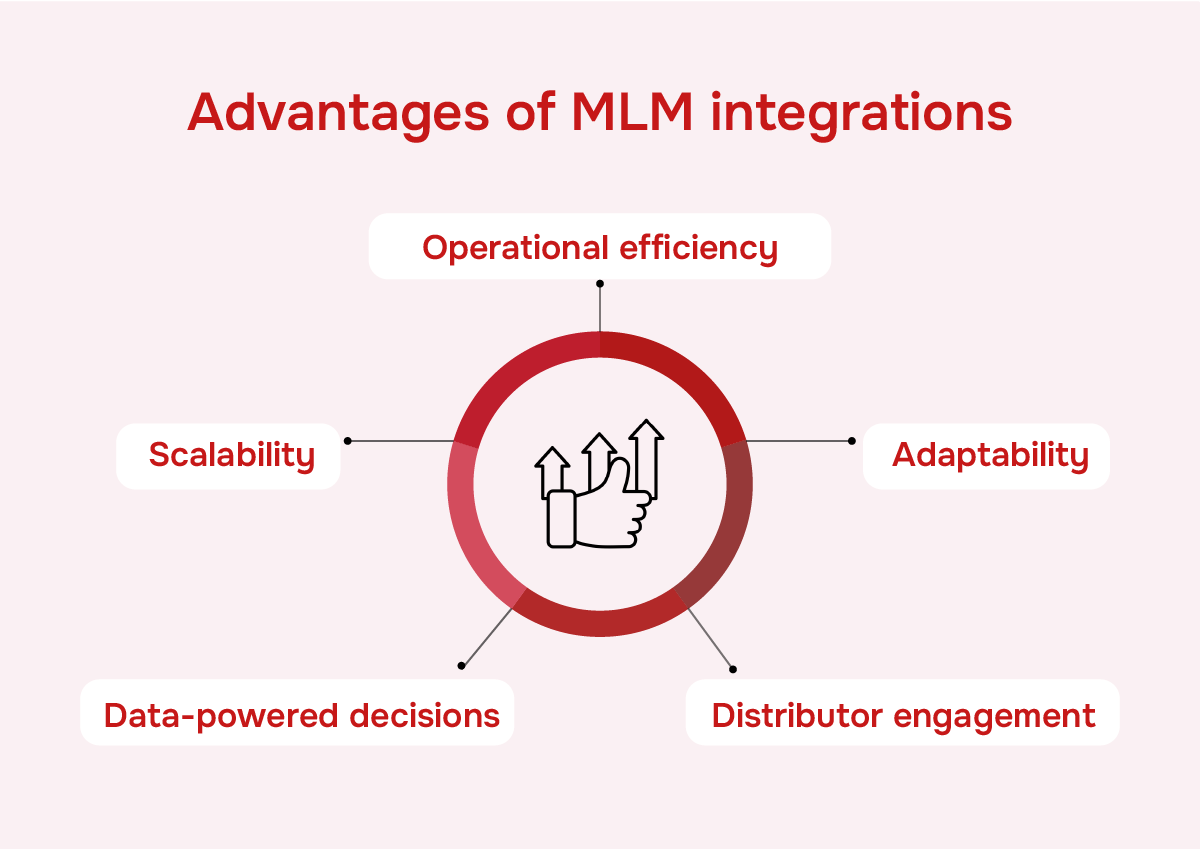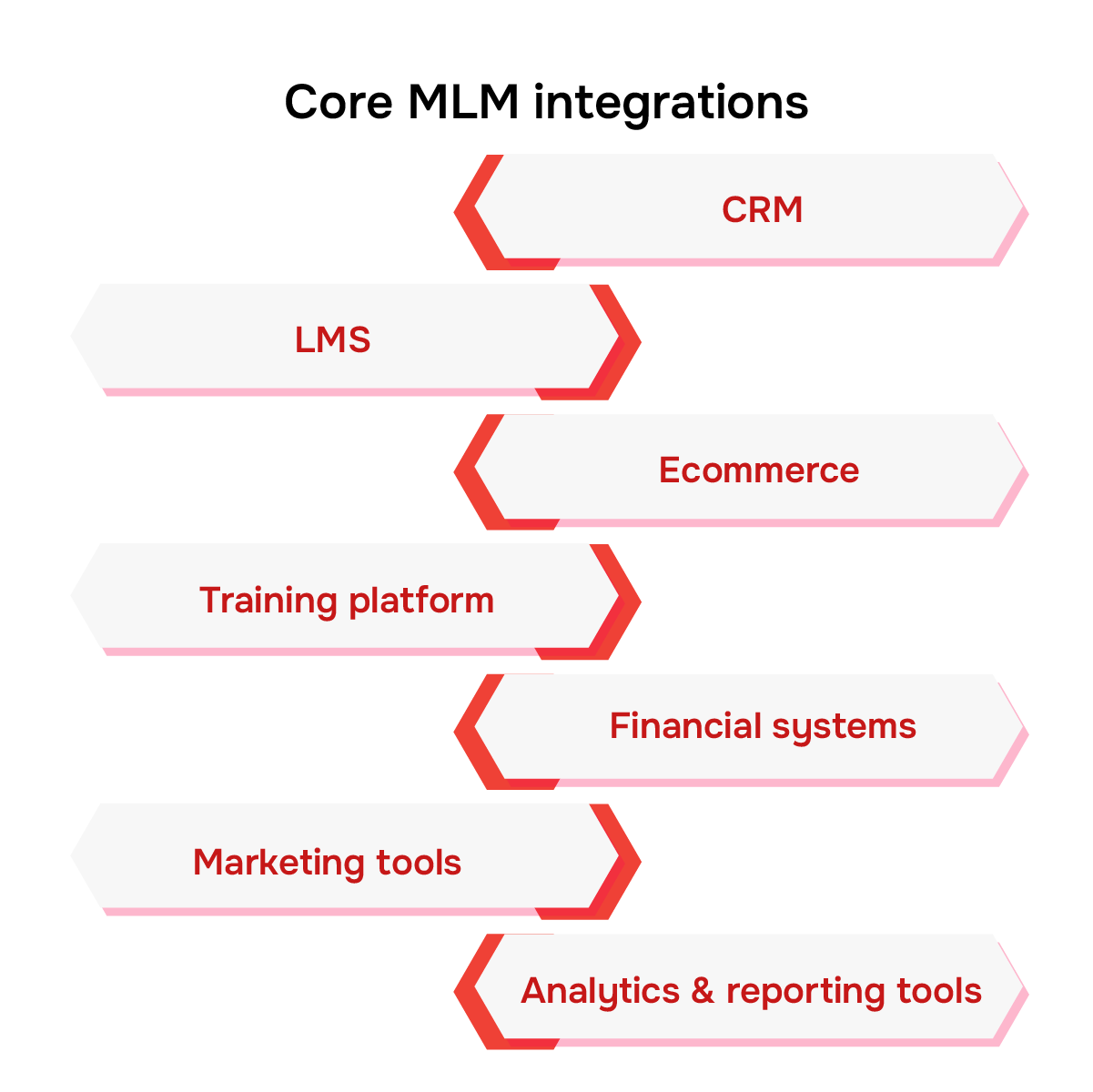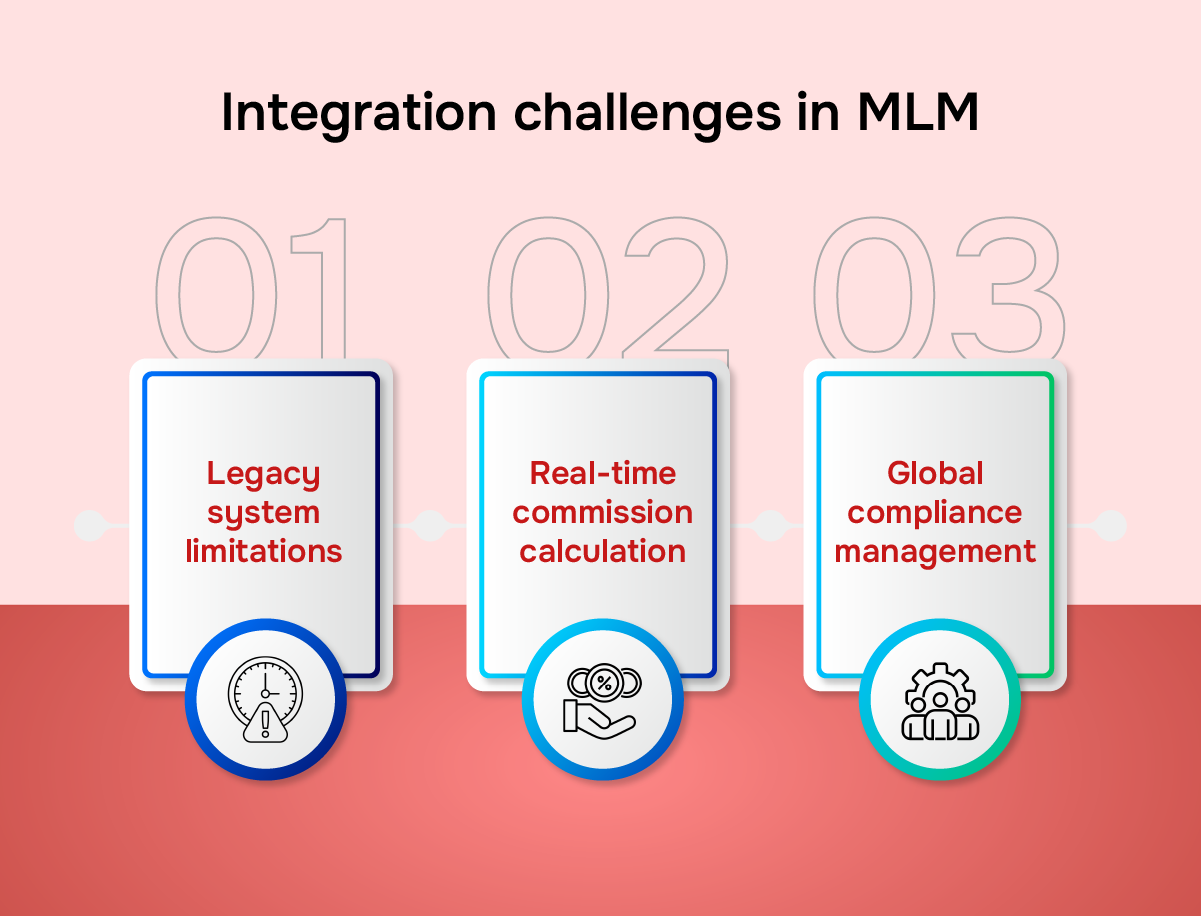MLM Integrations: Connecting your MLM platform with critical business tools

Introduction
Direct selling businesses once operated with simple technology. Even today, most direct selling companies apply a single-platform technology to manage their networks and operations. Even with sophisticated platforms and advanced technology applications, integration ecosystems become essential for operational efficiency, distributor satisfaction, and competitive advantage.
This white paper analyzes the key aspects of MLM integration ecosystems and why it has become crucial for businesses today. We analyzed various MLM companies and their integration ecosystems to identify the impact it has on these businesses. The analysis, therefore, reveals that companies with highly integrated MLM platforms are expected to experience:
43% higher distributor retention rates.
67% faster onboarding for new distributors.
28% reduction in administrative costs.
3.2x greater scalability in growth and expansion.
The white paper has been compiled to provide MLM businesses with a strategic framework for building an effective integration ecosystem that identifies critical integration points, addresses common implementation challenges, and offers a roadmap for futureproofing your MLM technology infrastructure.
The growing importance of integrations in multi-level marketing
Direct selling companies and the markets they operate in have changed significantly across social, economic and cultural aspects. When the network grows beyond geographical limitations the need to have a system that accommodates the challenges of operating markets becomes essential. Policies and laws differ from one region to another, people and their preferences change, and the market trends evolve tremendously. Businesses to operate among these fluctuations require adaptive capabilities.
An advanced MLM software can handle customer management, order processing, commission calculations, and distributor support. But the demands and challenges call for an extended system with diverse capabilities. Distributors expect commissions to be received in real-time and customers look for brands that provide seamless shopping experiences. Businesses, themselves, need diverse systems to monitor performance, manage compliance and improve their global operations.
Having all the specialized tools like CRM systems, ecommerce platforms, shipping platforms, tax management systems, accounting systems, in one centralized platform is nearly impossible and complex. And, with innovations moving at lightning-fast speeds, keeping pace with it becomes backbreaking for software providers.
Integrations thus becomes essential whereby companies can utilize the best technologies available without being affected by the limitations of a single platform.
The strategic value of Integration

Integration is not like any other technology necessity but a strategic one. MLM platforms with advanced integrations offer several advantages for businesses.
Operational efficiency: Eliminates data silos and aligns the business with region-specific regulations.
Distributor experience: Upgrades distributor experience across various aspects such as distributor onboarding, training, and engagement across all touchpoints.
Adaptability: Helps businesses adapt to various growth requirements.
Scalability: Ensures smoother global operations without downtime and operational disruptions.
Data-driven decision making: Delivers data insights on various business processes to aid businesses in their decision making process.
Essential MLM integrations for business growth

MLM businesses upgrade their capabilities integrating popular tools and platforms that complement their business growth. Integrations in MLM include CRM systems, shipping platforms, accounting and tax platforms, payment systems, analytics and ecommerce platforms.
1. Customer Relationship Management (CRM) integration
Integrating a CRM system to your MLM platform is crucial to overall business operations, particularly to customer acquisition and management. This interconnected relationship keeps the following processes in sync with the rest of operations.
Managing customer profiles: Maintain consistency in customer data across processes and platforms.
Downline management: Manage organizational structures in the predefined organizational hierarchy.
Communication history: Offer detailed history of customer-distributor interactions.
Activity tracking: Track distributor and customer activity and engagement across various touchpoints.
Lead management: Manage lead flow, segment them based on lead scores and assign them to the right sales team.
Case study
A health and wellness company faced inconsistencies in data handling related to customer and distributor records between their MLM platform and Salesforce CRM. Implementation of a bi-directional API integration with real-time synchronization eliminated data errors and expected to reduce customer support tickets by 38%.
2. Ecommerce and shopping cart integration
Customers and distributors are used to uninterrupted shopping experiences in their everyday life. They wish to experience the same with every brand they choose. Integration consideration for ecommerce platforms include:
Product catalog management: A centralized library that showcases all products and related information including offers and discounts.
Real-time inventory updates: Update stocks in real-time and notify stockouts and overstocking.
Order management: Streamlined process from order placing to delivery by keeping customers and distributors in the loop.
Customer-specific pricing: Personalized pricing and discount for privileged customers based on their rank or loyalty levels.
Abandoned cart recovery: Keep shopping carts accessible across all devices to help customers complete their purchases and businesses to recover lost sales.
Implementation Insight
For better performance, use an event-driven ecommerce system where inventory updates happen instantly across all platforms instead of waiting for scheduled syncs.
3. Payment processing and financial systems
Critically important for MLM business, integration of financial systems must be approached with accuracy, security, and scalability to ensure successful transactions and assured compliance. Financial system integrations require consideration of various features.
Payment gateways: The system must support multiple international payment methods.
Accounting system integration: Automated financial reconciliation of all business processes across various countries of operation.
Commission management system: Real-time calculation of commissions and timely payouts. Complete earnings visibility for distributors and administrators.
Tax compliance tools: Automated tax management based on regional tax laws and policies.
Currency conversion: Multi-currency support for global operations with real-time conversion capabilities.
Technical consideration
Payment integration should use idempotency keys to prevent duplicate transactions in case of communication failures between transacting systems.
4. Marketing automation and communication tools
Automated marketing platforms help distributors through various marketing activities. It improves sales efficiency and customer engagement through smart targeting and personalized approach.
Distributors need a strong support system to stay connected with their team and customers. Marketing integrations must therefore include
Email marketing platforms: Personalized communications based on customer geography and interests.
SMS and mobile messaging: Stay connected with customers and downlines at all times. Receive alerts and notifications on critical business processes and provide timely support to customers.
Social media management: Manage content across various social media platforms and ensure customer engagement.
Content management systems: Centralized resource libraries provide ease of accessibility and collaboration between teams.
Event management tools: Host brand events, manage registrations and attendance.
5. Training and Learning Management Systems (LMS)
Developing distributor skills is important for the growth and expansion of an MLM business. A rightly trained distributor is a perfect brand advocate who can confidently bring in long-term customers and consistent revenue.
In order to set your distributor training process right, training and LMS integration needs to be advanced and efficient with growth-optimized tools.
Training content management: Manage distributor training with centralized course creation, personalized course recommendations and interactive training modules.
Progress tracking: Monitor the progress of individual distributors, identify training needs and support distributors who require additional attention.
Achievement recognition: Provide certifications, manage leaderboards and celebrate training completions.
Personalized learning paths: Adapt training methods and courses to match individual distributor needs based on performance data.
Compliance documentation: Maintain updated compliance documents and reinforce regulatory training with stringent monitoring.
Case study
A beauty MLM company integrated their MLM platform with a specialized LMS with a view to increase training completion rates by 87% and reduce time-to-first sale for new distributors by 47%.
6. Analytics and reporting tools
Data-driven insights are powerful enough to lead distributors and organizations through a smarter and informed decision making process. This helps in efficiently tracking performance, optimizing strategies, and driving consistent business growth.
Analytics and reporting tools in MLM provide real-time visibility into key business performance metrics. Distributors can monitor sales, customer behavior, and team performance which are crucial to building effective sales strategies. When choosing to integrate analytics and reporting tools MLM companies must opt for analytics systems that include:
Centralized data collection: Gather data from multiple sources including CRM, sales platforms, and marketing channels.
Real-time reporting: Auto-generate and download live reports of various performance metrics.
Customizable dashboard: Track preferred business metrics on a customizable business analytics dashboard.
Predictive analytics: Gain AI-powered insights to forecast business performance, sales trends and customer demands.
Team performance analytics: Evaluate the performance of distributor teams with detailed engagement and productivity reports.
Strategies and best practices for successful implementation
Successful integrations promise businesses efficiency and long-term scalability. But this needs a foolproof approach. Following proven implementation strategies and best practices can help businesses in enhancing user experience and reducing risks.
The following section explores a structured approach to successful integrations in an MLM business.
API-first architecture
Prioritizing API infrastructure ensures scalability and flexibility to connect with external tools, mobile apps and third-party services. An API-first approach encompasses:
Complete API coverage: to ensure all features in the platform are accessible programmatically.
Versioned APIs: Backward compatibility for stable integrations.
Developer documentation: Complete and updated integration resources.
Sandbox environments: Testing functionalities for integration partners.
Rate limiting policies: Scalable access that prevents system overload.
Integration approach selection
Organizations can choose between several integration approaches that suit their purpose for an efficient and successful integration process.
| Approach | Suitable for | Considerations |
|---|---|---|
| Point-to-Point | Simple ecosystems with few connections | Gets complex when connections increase |
| Enterprise Service Bus (ESB) | Complex environments with multiple systems | Demands higher initial investment but offers better long-term scalability |
| iPaaS (Integration Platform as a Service) | Cloud-first organizations | Reduces implementation time but may incur ongoing costs |
| Webhook-Based Event Systems | Real-time operations | Excellent for notifications but may require additional infrastructure |
Data management
The data management system plays a crucial role in the success of MLM integrations. This must include:
Master data management: Establish authoritative sources for each data type within the organization.
Data quality: Define data validation rules and cleansing processes.
Conflict resolution: Determine how contradictory data is handled during the integration process.
Compliance management: Ensure data handling meets all related regulations and policies.
Audit trails: Maintain records of all multi-platform data modifications.
Common implementation challenges and solutions

MLM business structure is not like any other business model; it is complex. Increasing levels of complexity brings numerous challenges to the integration process. The process must focus on successful integration plus maintaining integrity of the data involved.
Here are some of the most common integration challenges organizations face in their integration process.
#1 Legacy system limitations
MLM companies operating with outdated or older systems makes it difficult to integrate modern API capabilities.
Solution
Database-level integration for read-only operations.
Development of custom middleware.
Scheduled ETL (Extract, Transform, Load) processes.
Planned phase-out with strategic migration plan.
#2 Real-time commission calculation integration
Commission calculation is a time-sensitive and crucial process for an MLM business. On-time commission payouts are a top factor that builds distributor loyalty and brand reputation. Managing and computing multi-tier commissions are a real challenge in the integration process.
Solution
Implement event-based architecture for sales transactions.
Develop caching mechanisms for MLM genealogy data.
Consider materialized views for complex downline calculations.
Use queue-based processing for peak periods involving a large number of transactions.
Provide estimated commission calculations for preliminary analysis with reconciliation process.
#3 Global compliance requirements
MLM companies operating internationally need to fulfill compliance requirements of the operating countries. Changing policies and regulatory standards creates a complex environment for integration.
Solution
Region-specific compliance modules with centralized compliance management.
Regulatory document integration with e-signature capabilities.
Automated rule enforcement based on regions of operation.
Integrated compliance training verification.
ROI analysis: Measuring the success rate of integrations
Setting up an integration strategy also includes consideration of Return On Investment (ROI) to assess their effectiveness and long-term value. Integrations are meant to reduce time, resources and improve revenue growth. Here is a brief analysis of two most important factors: Direct cost savings as an expected result and the estimated revenue and growth impact of integrations on the overall functioning of the organization.
Direct Cost Savings
| Integration area | Expected cost reduction | Primary savings source |
|---|---|---|
| Customer support | 20-35% | Reduced data-related inquiries |
| Data management | 40-60% | Reduced duplicate entries |
| Financial operations | 15-25% | Automated reconciliation |
| Compliance management | 30-50% | Automated documentation |
Revenue and growth impact
| Business metric | Estimated average improvement | Causal relationship |
|---|---|---|
| Distributor retention | +15-40% | Reduced operational friction |
| Activation rate | +20-45% | Streamlined onboarding |
| Average order value | +5-15% | Enhanced shopping experience |
| Expansion velocity | 2-3x faster | Reduced complexities in market entry |
Getting your MLM integration ecosystem future-ready
MLM integrations will advance with emerging technologies leading the development process. Modular microservices-based architectures, cloud native solutions, automation, and AI-driven analytics can enhance efficiency and adaptability as businesses grow and expand.
Emerging advancements in MLM integrations
AI and machine learning services with predictive analytics to analyze distributor and customer behaviors.
Voice-assisted platforms that can function as conversational interfaces for supporting distributors.
Augmented reality tools that can handle virtual product demonstrations and host engaging training sessions.
Blockchain infrastructure will be used for maintaining transparent genealogy and commission records.
IoT device integration to track product usage data and enable automated replenishment.
Architectural considerations for future flexibility
Microservices adoption: Decompose traditional platforms into modular infrastructure.
Event-driven architecture: Real-time responsiveness across business processes and systems.
GraphQL implementation: Flexible data querying across integrated systems.
Containerization strategy: Consistent deployment across various business environments.
Edge computing approach: Reduced latency and improved efficiency for global MLM operations.
Conclusion
The next decade will be led not by MLM companies with the most features built into their core platform but by those with the most effective integration ecosystems with connected sophisticated features and tools. Building such an ecosystem is a long yet fruitful process which requires a clear vision, technical expertise, and structured implementation.
Outgrowing the limitations with new integration possibilities will strengthen the efficiency and long-term scalability of businesses today and into the future.
Customer success stories: Leading MLM companies are driving remarkable results with competent solutions
Epixel MLM Software anchored 100+ network marketing companies to success through their business process automation in more than 88 countries. Let Epixel MLM Platform revolutionize your MLM business with 100+ proven features intelligently tuned for small, medium, and large enterprises.
